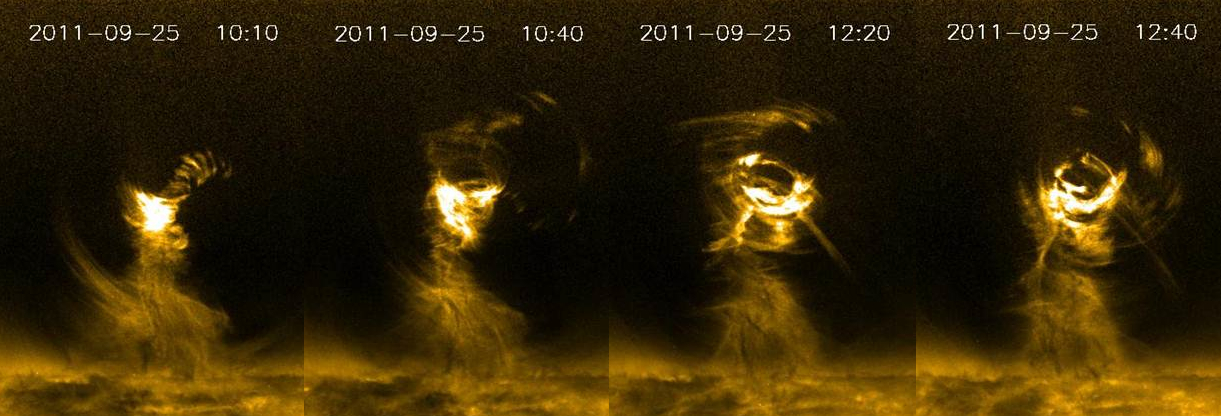Huge 'Solar Tornado' Twists Across Sun's Surface in New Video

A NASA spacecraft has captured video of a massive solar "tornado" five times wider than the Earth twisting its way across the surface of the sun.
NASA's Solar Dynamics Observatory (SDO) looked on as the huge, swirling storm raged on Sept. 25, 2011, spinning solar gas at speeds up to 186,000 mph (300,000 kph), researchers said. Here on Earth, tornado wind speeds top out at around 300 mph (483 kph).
"This is perhaps the first time that such a huge solar tornado is filmed by an imager," Xing Li of Aberystwyth University in Wales, who analyzed the SDO footage, said in a statement. "Previously, much smaller solar tornadoes were found by the [NASA/European Space Agency] SOHO satellite. But they were not filmed."
Li and other researchers will present a movie of the tornado Thursday (March 29) at the 2012 National Astronomy Meeting in Manchester, the United Kingdom.
SDO's instruments saw gases as hot as 3.6 million degrees Fahrenheit (2 million degrees Celsius) rise from a dense solar structure called a prominence, then travel about 124,000 miles (200,000 kilometers) along a spiral path into the upper solar atmosphere, researchers said.
Unlike Earth's tornados, which are driven by wind, solar twisters are shaped by our star's powerful magnetic field. They often occur in concert with violent explosions of solar plasma known as coronal mass ejections, or CMEs. Some researchers think the tornados may help trigger CMEs, which can streak through space at several million miles per hour.
CMEs that hit Earth can wreak havoc on our planet, causing temporary disruptions in GPS signals, radio communications and power grids. They also typically supercharge the dazzling light shows near Earth's poles known as the northern and southern lights.
Get the Space.com Newsletter
Breaking space news, the latest updates on rocket launches, skywatching events and more!
The $850 million SDO spacecraft, which launched in February 2010, is the first in a fleet of NASA efforts to study our sun. The probe's five-year mission is the cornerstone of a NASA science program called Living with a Star, which aims to help researchers better understand aspects of the sun-Earth system that affect our lives and society.
The sun is currently in an active period of its 11-year weather cycle. The current cycle is known as Solar Cycle 24 and will peak in 2013.
Follow SPACE.com for the latest in space science and exploration news on Twitter @Spacedotcom and on Facebook.
Join our Space Forums to keep talking space on the latest missions, night sky and more! And if you have a news tip, correction or comment, let us know at: community@space.com.

Space.com is the premier source of space exploration, innovation and astronomy news, chronicling (and celebrating) humanity's ongoing expansion across the final frontier. Originally founded in 1999, Space.com is, and always has been, the passion of writers and editors who are space fans and also trained journalists. Our current news team consists of Editor-in-Chief Tariq Malik; Editor Hanneke Weitering, Senior Space Writer Mike Wall; Senior Writer Meghan Bartels; Senior Writer Chelsea Gohd, Senior Writer Tereza Pultarova and Staff Writer Alexander Cox, focusing on e-commerce. Senior Producer Steve Spaleta oversees our space videos, with Diana Whitcroft as our Social Media Editor.









